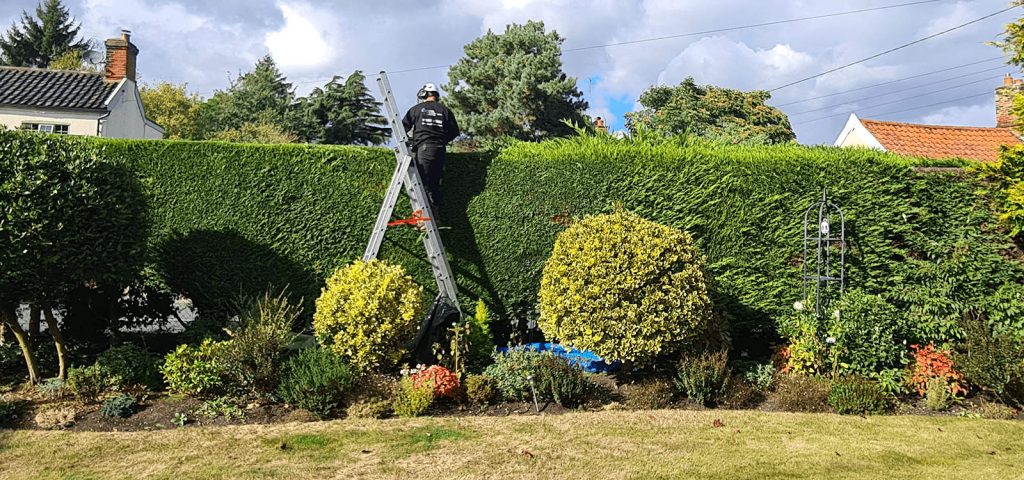
How to care for your garden trees – top 10 UK garden favourites explained
Maintaining the trees in your garden is crucial to their health and longevity. Trees provide numerous benefits such as shade, privacy, and attracting wildlife, making them a valuable addition to your property. As a trusted tree surgeon in East Suffolk and Norfolk, we’ve put together a care guide for the top 10 UK garden tree favourites.
Whether you have a Silver Birch with its distinctive white bark, a Crab Apple with its colourful autumn fruit, or a Hornbeam that produces dense foliage, our guide covers everything you need to know to keep your trees in the best possible condition.
Our Lowestoft team offers professional tree care services to ensure your trees remain healthy and attractive. From light pruning to complete tree removal, our team of experts is equipped to handle any tree-related issues you may have.
For those in Beccles, our Beccles tree surgeon service offers the same high-quality services, providing you with peace of mind that your trees are in good hands.
Don’t wait until your trees are beyond repair, contact us today to schedule a consultation and see how we can help you care for your garden trees
.
1. Silver Birch (Betula pendula)
Sporting a distinctive white bark and delicate, triangular leaves, the silver birch is a beautiful tree that is delightfully low maintenance. All that really needs to be done to keep the plant healthy is light pruning, such as removing any dead or diseased branches. It can also be beneficial to prune very crowded and congested areas to improve air flow and light penetration.
Warning signs: Be on the lookout for leaf rust, which can be identified by any orange, yellow, brown, black or white pustules on the foliage. Also, if you spot any branches that are dying off within the crown, there could be a risk of birch dieback. Be sure to prune these affected areas in late spring or early fall to keep the tree in good health.
2. Crab Apple (Malus spp.)
These small, ornamental trees produce beautiful spring flowers and colourful fruit in autumn. They thrive in wide open and sun-drenched spaces with well-drained soil. If it gets particularly dry over the summer, especially in young crab apple trees, it’s generally a good idea to water them occasionally.
Warning signs: Generally speaking they need very little pruning, but be sure to remove any dead, diseased, or damaged branches in spring. Pruning the tree from July onwards can pose a risk of greatly reducing the amount of flowers and fruit produced in the following season.
3. Rowan (Sorbus aucuparia)
Also known as the Mountain Ash, this tree is valued for its attractive berries and autumn foliage. For the best results, water the plant in very dry weather and mulch annually with your compost of choice. Make sure you prune suckering shoots coming from the base of the tree, and prune dead or damaged branches between late autumn and spring.
Warning signs: A distinguishing feature of the rowan tree is of course its bright red berries. If you want to harvest them to extract the seeds and start your next crop of trees, it’s best to pick them between August and early September. You don’t want to leave it too late, or the birds might beat you to it! Also, be very careful not to remove next year’s bud, otherwise you risk causing damage to the tree.
4. Cherry (Prunus spp.)
Prized for their spectacular spring blossoms and sweet summer fruit, cherry trees are becoming increasingly popular in the UK. Of course, its bright red fruit doesn’t just attract humans to these wonderful plants! Consider netting or scarers to keep passing birds away, and beware other pests like mites and fruit flies that could be after your haul.
Warning signs: Whilst cherry trees can go weeks without watering, you should look to maintain moist soil around the base of the tree. Consider using something like a soaker hose for deep watering. Pruning away the dead and decayed branches is good for the tree’s health as well, but also has the added benefit of maintaining the shape of these beautiful trees.
5. Hornbeam (Carpinus betulus)
deciduous tree that forms a dense, compact hedge or screen and produces yellow autumn leaves, Hornbeam is a large tree that is native to the UK. You’ll want to keep it watered in its first year, whilst the roots are establishing. After this point, the rain should provide all the moisture it needs, making it a very easy plant to care for. You may want to have your hornbeam hedge coppiced or pollarded to keep it a neat and compact shape. Clip it in mid to late summer to keep it looking neat and tidy.
Warning signs: Things to look out for with hornbeam trees include yellowing or browning leaves, dead or damaged branches, and excessive leaning or instability. If you notice any of these signs, it may be necessary to seek professional assistance to diagnose and address the issue
6. Scots Pine (Pinus sylvestris)
You’ll find this tall, evergreen conifer widely planted in UK gardens. Unsurprisingly native to Scotland, the Scots pine can grow to 35 metres in height and live for up to 700 years. With such a long lifespan, it’s clear that they need very little intervention when it comes to their care.
Pruning dead or diseased limbs is the most care you will need to provide this hardy species. It’s a good idea to trim these just past the branch collar, which is the thicker area where the base of the branch connects to the trunk. Pruning like this will encourage new branches to grow, forming a compact structure that looks great and is easier to maintain.
Warning signs: Keep an eye out for any needles that are turning brown, as this could be a sign of a fungal infection. You should also watch out for pests like pine beetles, which can burrow into the tree and cause significant damage.
7. English Oak (Quercus robur)
The English oak is a grand, slow-growing tree with distinctive lobed leaves that have given it an iconic status in British culture. They need a lot of water, especially when they are first establishing themselves. A weekly drenching of the soil is required for the first couple of years, which stretches into a monthly watering when the tree hits maturity.
Young trees (under three years old) should only be pruned to remove dead or diseased branches. After this point, when the tree has had a chance to mature, you can prune the canopy to help shape it, but it’s recommended to only trim inner branches that block sunlight from reaching significant parts of the plant.
Warning signs: If you notice any discoloured or wilting leaves, it could be a sign of a fungal or bacterial disease. Additionally, be on the lookout for pests like the oak processionary moth, which can cause damage to both the tree and human health.
8. Holly (Ilex aquifolium)
Holly is a very popular evergreen tree with shiny, spiny leaves and red berries that are a festive favourite, often spotted on Christmas wreaths. Not only do they look pretty, but they make a very effective barrier that can help keep your garden secure.
Like with a lot of trees on this list, holly plants are incredibly easy to maintain, with established plants only really needing water during very dry summer weather. Should you choose to prune the plant, it can be done at any point in the year, however a spring prune would be the best way to ensure plentiful berries.
Warning signs: While holly plants are relatively low maintenance, keep an eye out for signs of leaf spot disease, which can cause black spots on the leaves. You should also be aware that the berries are toxic to humans and pets if ingested
9. Common Beech (Fagus sylvatica)
Fantastice by itself or as a hedge, beeches are a deciduous tree with smooth, grey bark and glossy, green leaves that turn golden in autumn.
If you have your beech as a hedge, it’s recommended that you trim it to the shaped and size you want around August. This allows the hedge to retain its latest set of leaves throughout winter, ensuring you have a year-round screen. You can cut a beech in the colder months, but it’s recommended to wait until February, just when it’s starting to feel a bit warmer (well, not freezing at any rate!)
If you’re nurturing a beech tree, it’s recommended to prune between autumn and the start of spring. Just be carefully not to create cuts larger than 6cm in diameter, as these might not heal easily and cause lasting damage to the tree.
Warning signs: Watch for signs of beech bark disease, which can cause significant damage to the tree if left untreated. Additionally, keep an eye out for pests like the beech leaf-mining weevil, which can cause extensive damage to the foliage.
10. Yew (Taxus baccata)
A slow-growing conifer with dark, evergreen foliage that is often shaped into topiary or hedgerows, yew provides an excellent green backdrop for more colourful plants. It’s also very simple to care for, thriving in both full sun and fully shaded spots.
So long as your yew is growing in well-drained soil, they should continue to grow without any additional input. They require pruning to maintain a regular shape, but be careful not to cut too deep, as over-trimmed areas can take years to grow back. Also, avoid cutting the upwards growing tips until your yew has reached its desired height.
Warning signs: Although yews are generally hardy plants, keep an eye out for signs of root rot, which can be caused by overwatering or poorly-draining soil. You should also be aware that all parts of the yew tree, except for the fleshy red berries, are highly toxic if ingested.
In summary, these 10 popular trees in UK gardens are easy to maintain with a little bit of care and attention. It’s important to keep an eye out for warning signs such as leaf rust, discoloured leaves, or pests, as they can be indicators of serious issues that need to be addressed. Regular pruning is also recommended to keep your trees healthy and looking great. If you’re looking for a professional tree surgeon to help with your tree care needs, check out our pricing page for more information. We provide tree surgery services in Lowestoft and Beccles, so don’t hesitate to contact us for assistance with any of your tree care needs.
